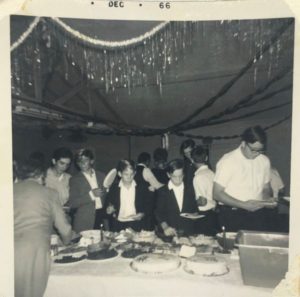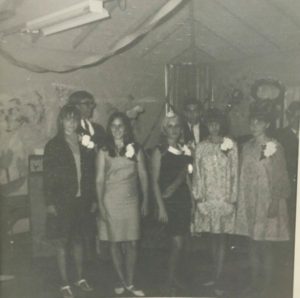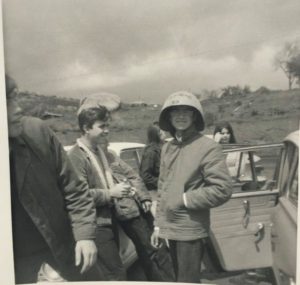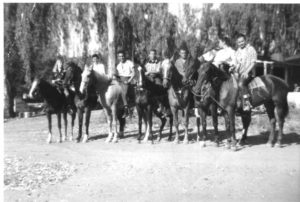Suncrest and La Cresta Merge 1950s and 1960s
The Crest Civic League notes reflected that as of November 1950, “There are now approximately 1,200 residents based on a total of 275 water meter users in the Crest Public Utility District. The District is connected to the La Mesa-Lemon Grove-Spring Valley Irrigation District water mains as of May 1950. The climate is good. We have less fog than El Cajon Valley, San Diego, and all its neighboring cities. We have all the conveniences of a healthy community – stores, a café, two churches, utilities, excellent fire protection, the services of a good doctor living in this community, and registered nurses.”
The communities of Suncrest and La Cresta were beginning to share common goals: fire protection, water, and education for their children. Thoughts of merging the communities was starting to be discussed. Crest archives showed that our residents were busy improving our community by these notations:
Mr. Dave Allabough, president of the Crest Civic League, reported that a white line will continue from the present line on the black top on the Crest. The cost will be very little, and each property owner will be asked to pay it. The State is to improve where the Crest traffic enters from Highway 80.
A revision has begun to determine whether the present fire insurance rates in the Crest area can be reduced some; we have good water facilities and an excellent Fire Department.
The Cajon Valley Union School District has asked Suncrest Inc. if they will consider selling part of the Suncrest Park, if so, what price. This matter is to be brought before the membership.
County Park Department has begun the job to make our South Lane Park a really attractive place. Already, undesirable trees and stumps have been moved. Various buildings are to be painted and a horse court with spectator’s seats, various shrubs, and grass is to be planted.
Crest in the 1950s
Crest continued to thrive in the 1950s. Research showed that Stanley Kubik, Alpha Realty, and Clyde Holmes were three local realtors. Marty Jacks Café located at 1629 La Cresta Blvd. offered homemade pies, cakes, and special chicken pies. Lewis De Garmo sold western and frontier styled pants, shirts, and jackets at his 137 Scenic Drive location in La Cresta. There was even a local dentist, S.P. Marshall, located on 118 Scenic Drive, La Cresta. Sal’s Suncrest Market and General Store offered sundries, notions, and Dutch Boy Paint. You could call H4-3646 for free delivery.
Crest was a very active social community in the 1950s. The Crest Civic group and the La Cresta Women’s group sponsored flower shows and dinners. In 1958 Wesleyan Methodist Sunday school class was held at the La Cresta Clubhouse. In 1956, a local square dance club, the Hix Mixers, was active at the Suncrest Clubhouse. Sometimes the club members would meet and practice, barbeque and swim at the Jenkins picnic area where Bill and Dewey built a custom outdoor dance floor. The group helped lay the floor in the Suncrest Clubhouse where they performed. The Suncrest Clubhouse and the La Cresta Clubhouse continued to be the hubs of activity in the Crest community.
The Crest Volunteer Fire Department in the 1950s

The Volunteer Fire Department was active in the 1950s. A fourth annual Jamboree was held in 1950 to support the purchase of two fire trucks and a fire station. More than 1500 community residents annually contributed material and labor for this event. In 1954, money was raised for the fire department by membership rather than rummage sales, dinners, and jamborees, to support the yearly budget of $2,223. The Women’s Fire Auxiliary continued to work hard to support the fire protection efforts through performances and other fund raising activities. The 1957 Crest Volunteer Fire Association recommended a tax be levied for the purpose of operating and maintaining a fire department. This was meant to equalize the burden of support to all property owners. It was stated that only 50% of the residents were contributing to the support of the fire department. The tax was not intended to require paid firemen, nor did it mean Crest fire protection would be taken over by any other agency. A taxable fire district was proposed so that the fire department could serve the needs of the community with a minimum budget on a sound financial basis.
Fires in the 1950s. 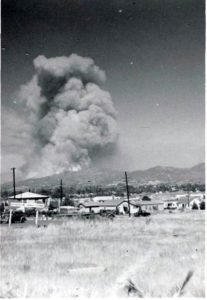
Fires in the 1950s were a big concern. The following fire information was retrieved from the Crest Historical Society archives:
June 28, 1950 – fire on the Jarrett property destroying a barn and moved up the north side of Lilac Drive. The fire was caused by children playing with matches. Crest volunteers kept the flames under control until five forestry service trucks arrived. Twenty five-houses were saved as they labored in the extreme heat of the midday. It was estimated that approximately 10 square blocks were razed.
July 1950 – 300 firemen and 18 trucks fought a fire lasting 24 hours. It was San Diego County’s second worst brush blaze sweeping 3,000 acres with 300 firemen and 18 trucks The wind carried flames up Rios Canyon to Oakridge and past the Crest, then swept out along the east side of Mountain View Road. It was thought that an unattended campfire might have started the fire.
June 1951 – More than 100 state, federal, and volunteer firefighters battled the 500 acre terrain south of Suncrest. Brush on the 1,900 foot hill just south of Suncrest was burned right down to the rock and boulders. An overnight field camp was set up at the edge of the still smoldering fire at the top of the old Suncrest south grade.
July 10, 1951 – A fire broke out near South Lane in Suncrest in the brush, near a well digging crew, and quickly spread over a 250 acre area. Two summer homes were lost at Suncrest. The flames burned out the brush between the area’s 100 homes. This Suncrest fire, which at one time threatened to be a major disaster, miraculously spared nearly all the homes. The firefighting crews had the fire practically under control in four hours. Firefighters from La Mesa, El Cajon, Crest and Harbison Canyon, Riverside, Valley Center, Elsinore, San Bernardino, Cuyamaca, Lyons Valley, Ramona, San Marcos, and the State Division of Forestry successfully fought the fire. Many sheds, small frame structures, and some telephone and power poles burned and crashed to the ground. An hour after the fire broke out, the underpinning on one of the community’s three large water tanks burned and the huge tank toppled to the ground. Forest Service tanker trucks were forced to go to the bottom of the west slope of the ridge for water. There was an estimated $25,000 in damages.
Evelyn’s Beauty Shop
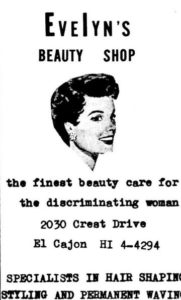
Opened in 1954 by Evelyn Behrens, it closed in 2000; a business in Crest for 46 years! “Drive a Little. Save a Lot” was the advertising slogan for Evelyn’s Beauty Shop. The price for a hair-cut was $1.50 in 1954. For the same price you could get a shampoo and set. Thirty-four years later the price was $3.00 for those services. Originally the shop was located next to the Hilltop Inn on La Cresta Blvd. (across from Rainbow Market). In 1955, it was moved to Evelyn’s home at 2030 Crest Drive. In January 1999, Evelyn Behrens suffered a heart attack and was advised to close her shop. Evelyn Behrens died in December of 2004.
Crest Auto Repair
Located at the top of the Crest grade at 128 La Cresta Road, Crest’s repair center was built in 1951. Mr. A.O. Alexander built the station, sold gas, and performed minor repairs. It was later sold to Mr. Younghusband for a short time and then to Mr. Jim Thurman. Jerry Di Meglio bought the shop from Mr. Thurman and has been the owner of the only car repair shop in the area for the last 40 years.
Life in Crest in the 1960s
In December 1967, Crest boasted a population of approximately 3,000 residents. Most houses were small and humble “nothing fancy or elaborate.” Only a few houses could be called luxurious. Water meter connections revealed that 470 families resided in Crest in 1967. Kubic Realty Company stated that Crest added 6-12 new homes a year at that time. The La Cresta Heights sub-division was the new development beginning in the late 1960s. The ads stated that existing homes were selling for around $15,000 while new homes sold between $25,000 and $30,000. An empty lot in 1967 sold from $2,200 to $2,700 an acre. Financing could be a challenge since institutions were averse to making a commitment to a mountain community which seemed sequestered. This kept expansion to a minimum. One article during this time described the area as “a poor man’s Mt. Helix.”
Crest archives reported:
There were still problems reported in the community including side streets that were rough dirt roads, privately maintained, or not. There were no sewers or natural gas – only electricity and butane. There was no zoning as yet. In 1964, Crest Elementary School had an enrollment of 204 students. This number increased to 242 by 1967.
From 1962 to 1964, the Crest Weekly News was written by June Huntington. The cost was 5 cents per issue.
Crest had a service station at the top of the hill in the 1960s. It was called Younghusband & Sons Phillips 66 Station. There were two grocery stores, a tavern, three churches, and a malt shop which was located across the street from Nancy Jane Park.
The Crest Public Utilities Commission served the La Cresta and Suncrest areas. Water connections were available for $110 because there were no bond obligations. Rio San Diego Water District, however, which served the La Cresta Heights area, still had bond obligations which made the water meter connections a steep $565.
The Crest Civic Group and the Crest Young Christian Students, a Catholic Church group, were two organizations operating during this time.
What was Happening in Crest in the 1960s?
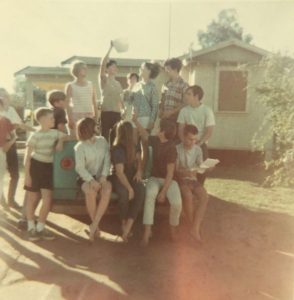 For teenagers on the hill, activities included swimming, playing ball, socializing with the other kids, riding horses, participating in car washes at the firehouse, and hanging out at the malt shop across the street from Nancy Jane Park. In 1966-67 The Crest Teens Club gathered for fun events including a Turkey Raffle (photo left – More photos below), Christmas Dance, and car washes. Thanks to Kathryn Younghusband for the photos.
For teenagers on the hill, activities included swimming, playing ball, socializing with the other kids, riding horses, participating in car washes at the firehouse, and hanging out at the malt shop across the street from Nancy Jane Park. In 1966-67 The Crest Teens Club gathered for fun events including a Turkey Raffle (photo left – More photos below), Christmas Dance, and car washes. Thanks to Kathryn Younghusband for the photos.
Baseball was big in Crest at that time with Jim Younghusband as team manager. The Crest Hawks was a triple A softball team in the San Diego municipal league in the 1960s. Bill Farris, longtime Crest resident, was a pitcher on the team.
Besides baseball, there were a number of other organized groups including the Crest Civic Group, Crest Teen Club, Crest Women’s Club, Cub Scouts, Boy Scouts, PTA, and VFW Post 1052.
It seems like there were plenty of shopping opportunities based on the list of stores and services found in the archives. These included: Jewell’s Treasure Box, Sperry’s Student Art, Avon Products, Inc., Ted’s Barber Shop, Evelyn’s Beauty Shop, Mary’s Beauty Hut, Foster Construction, La Cresta Campers, Dr. McClurkens Physio-Therapy Chiropractic Treatment, Yoga, Ruth’s Hobby Shop-Ceramics, Amway, Charles Martin Locksmith, Hilltop Market, Suncrest Market, Rossney Drum, Mary Garzer, Notary, Charles Floto Piano Tuning, John Rodgers Furniture Refinishing, Garow Printing, Kubik Realty, Hilltop Inn, and Mt. View Electronics.
Julie Dutcher provided a glimpse of growing up in Crest in the 1960s.
“My parents’ names were Wendell and Martha Dutcher. They ran Suncrest Market from 1962 to 1970. Crest was like ‘Mayberry’ back then! Suncrest Market is where the Crest Library is now. My parents gave free credit to their customers and my mother delivered groceries to some shut-ins for free! They ran it 7 days a week from 9-7 p.m. for many years. They drove ‘to town’ (El Cajon) on Mondays to buy incidentals; they took special requests and always had small gift items on hand like coffee mugs, greeting cards, coloring books, small toys, trendy towels, and washcloths. My mom had SO MUCH ENERGY that she even ironed sheets and pajamas! She and most ladies used outdoor clotheslines to dry the clothes. She was constantly doing housework, grocery store work, cooking full meals each night, and never hired cleaning people for anything. The store and house were spotless!
“In the 1960s through 1970s, the Crest Community Church ran a club for the local children called ‘Friendship Hour.’ It was wildly popular.
“One of the local churches used to play bell chimes around 6 p.m. on Sunday evenings. It was a simple and sweet melody or a series of chimes. It was really beautiful! It was the church across the street from Crest school (the small church not the larger Crest Community Church). Brother and Sister Boone ran it. It was a beautiful sound that called all people to come and worship God. The local Catholic Church, St. Louise de Marillac, also tolled church bells at 8 a.m. and mid-morning. The altar boys were trained to toll the bells for a short duration. It was all part of the sounds and sights of living in Crest since those churches were built. Sadly, regulations may have ceased the ringing of the church bells in today’s world.”
Interestingly, others had different memories; the chimes were a bit loud, they rang a bit too long, and they made their dog’s ears hurt. Different folks – different memories.
Julie continued, “Young girls in the 1960s to early 1970s collected and played with troll dolls. We also collected horse statues which were really popular. Boys played with G.I. Joe’s as well as played ‘Cowboys & Indians’ and ‘Cops and Robbers’– and used slingshots to hunt birds. Bike riding was popular.”
Crest – The Official Name of the Hill Communities
In the 1960s the communities finally decided to merge. It took a while before the communities of Suncrest, La Cresta and La Cresta Heights could agree to “Crest” as the official name. Prior to the residents choosing Crest as the community’s name, it was tentatively called Crest Village. It was also referred to as a twin district because of its two halves. It was even suggested that the community be called “The Crest.” Residents of Suncrest objected to this name because everyone knew that La Cresta translated was “The Crest.” It was finally decided in the 1960s that “Crest” was a name that would be satisfactory to both sides of “the hill.”
The Crest Civic League inquired and found there were no other communities named Crest and set to work to establish a post office as another step toward establishing “Crest” as the official name. Since the Crest Public Utilities Commission, the Crest School, and the Crest Fire Department had already been established, Crest seemed the logical choice. The league wrote the San Diego County Board of Supervisors asking how they could officially establish the name. The Board had a simple answer, “Put up a sign.” It is still common today to see maps showing La Cresta and Suncrest when describing the Crest area.
Crest’s First Post Office
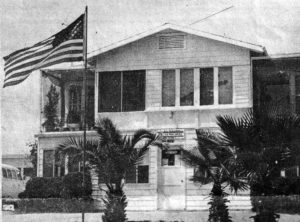 Alma Rice was considered to be the first Postmistress for the community. Located in the Rice’s store on the corner of Burdett Way and La Cresta Blvd (where the Rainbow Market parking lot is located). It was later moved to the downstairs basement of a two story house on 113 Burdett Way. Mrs. Rice then moved the post office to a retail building which was on the east side of La Cresta Blvd. between Sierra Vista Drive and Wilkie Way. Later it was moved to the Rice home which was the first house on the northeast corner of Sierra Vista Drive and La Cresta Blvd. where it remained until June 30, 1969 when Alma Rice’s contract ended.
Alma Rice was considered to be the first Postmistress for the community. Located in the Rice’s store on the corner of Burdett Way and La Cresta Blvd (where the Rainbow Market parking lot is located). It was later moved to the downstairs basement of a two story house on 113 Burdett Way. Mrs. Rice then moved the post office to a retail building which was on the east side of La Cresta Blvd. between Sierra Vista Drive and Wilkie Way. Later it was moved to the Rice home which was the first house on the northeast corner of Sierra Vista Drive and La Cresta Blvd. where it remained until June 30, 1969 when Alma Rice’s contract ended.
In 1969, Mrs. Darlene Pliscott was sworn in as Postmistress for Crest by Leroy Stewart. Ada Pliscott, Darlene’s mother-in-law, was sworn in as assistant Postmistress. The post office was in the bottom front room of the Pliscott two-story residence at 1249 La Cresta Blvd. An attempt by the US Postal Service to close the Crest Post Office in 1975 led to “mutiny on the hill.” Through the efforts of the media, residents, and U.S. Congress-men, the post office remained open and the Pliscotts continued to serve Crest until 1983.
Marge Fehlberg took over the post office duties in her home at 2015 Suncrest Blvd. from December 1, 1983 until January 4, 1988. After that, the postal service in Crest was discontinued by the US Postal Service due to budgetary constraints.
One more attempt was made at bringing a post office to the hill in 2010 when Tony and Pati Shammas, owners of Crest Foods, brought a sub-station to the top of the hill. Unfortunately, they sold the store the next year and the postal services were discontinued.
The Crest Country Store
John and Celia Scheutenhelm built the Crest Country Store in 1960. It was located at the top of the La Cresta grade on La Cresta Blvd. and they owned it for a few years. A couple of years later the building was sold to a camper factory, then a pool table manufacturer. It then became Levicios Grocery Store, and later became Crest Foods owned by Tony and Pati Shammas. It is presently owned by Kevin Delly.
The Blue Diamond Pool
There was a second pool in operation open to the public in the 1960s. The pool was called the Blue Diamond. It was located on Paloma Lane and owned by J.B. Browning and his wife, Helen. It cost 25 cents to swim for two hours. Before opening for the summer, the Brownings’ called the local children to help do yard work in exchange for a free swim in the pool. Although the pool was short lived because of insurance problems, there are many past and current residents of Crest who have fond memories of the Blue Diamond Pool.
Crest Roads
In 1962, the Crest Civic Group was working with the county supervisor to improve the roads in Suncrest. There was also a major widening and repaving of the La Cresta Road which was dedicated in 1966. A local paper reported the event and showed Kathy Reynolds, age 14, as queen of the event.
Crest Assembly of God Church
The Crest Community Church moved their little chapel to the new church location on Suncrest Blvd. in 1960. The original building, behind where the little chapel had been on Madera and Lento, remained. The Crest Assembly of God Church held its first service with 12 people on April 9, 1961 at this location. Later, it became the Lighthouse Christian Center and then the Cornerstone Church. The church closed in 2010 and the building was sold in 2013 to a Crest resident.
Horse Groups in Crest
In the 1950s, horses were popular in Crest as seen by this photo taken in 1957 in front of the corner house on Juanita Lane. As one Crest resident recalled, “We teenagers got together every chance we could and rode to our hearts content without a care in the world.”
Several horse clubs are mentioned in the Crest historical archives. One such club was founded around 1967 or 1968. The intention was to provide and maintain trails in the area and promote good horsemanship through safe equestrian activities. The club learned about an organization named Equestrian Trails, Inc. which provided good insurance and help with trail issues; therefore, the club became Corral 77 of ETI. The members marched in parades and had a large banner which two riders carried. They had matching vests, saddle blankets. and their own logo.
This was the beginning of the many horse shows in Crest. Funds were needed to accomplish their groups’ goals. A good food booth could raise money for an organization. Crest had a great area for these shows – South Lane Park, although it was not an official park at that time. Many years prior, the Crest Civic Group had constructed an arena using rails made from branches trimmed off the eucalyptus trees. Food booths at these events became famous as a good moneymaker, and kept the crowds coming to Crest for the club’s activities or just to eat. The shows were also dual purpose; they provided a safe activity and promoted good horsemanship.
Gilbert Mastri recalled, “The Crest ETI Chapter, as I recall, was active twice. The second time it was called Corral 18, in the 1970s and perhaps into the early 1980s. ETI Corral 18 was responsible for getting the Concessionaire Agreement with the County of San Diego for the use of what is now known as South Lane Park. As the years went by, the original ring was replaced with one made of pipe and purchased by the club. An announcer’s booth, a portable food booth, and some bleachers were added all from either donations or funds raised from the club. The park was also used for training clinics, veterinarian clinics, and various other activities. The Fletcher family was generous enough to allow the horse group to use their dining hall at Oakridge Park, known today as Crestridge Reserve, as a place for monthly business meetings for many years. Crest’s first Trail Trials was conducted at Oakridge Park and the surrounding area. It was a huge success, with the huge steak dinner bringing in the bucks.”
Other Crest organizations worked with the horse groups in their fundraising efforts. The Crest Volunteer Fire Department and the Crest Civic Group took advantage of Crest’s love of horses. Horse shows were held in Crest sponsored by these local organizations, drawing great crowds and assisting in their fundraising efforts throughout the years.
Kandhy Franklin, a long time Crest resident reported that The E-Crest-Rians, as a club, has been on and off several times over the past years. It was re-established again in the 1990s. Health clinics and fun shows and Triple Crown trail trials were held until 2007.
Other groups mentioned in the archives include the Crest Horse Club in the 1980s and the Crest Golden Lariats Riding Club in the 1960s. Lorraine Purviance shared: “John Longbehn, my dad, helped organize the Golden Lariat Riding Club as the adult advisor. He worked for the County of San Diego. A bunch of us who rode horses came together and he helped us elect officers and put us in touch with materials. I remember drawing the lariat and horse head. We were later the E-Crestrians when we expanded to include organized trail riding. He helped arrange to have meetings in the church basement to start with.
While horse group have become dormant in recent years, you can count on the horse community being ready to rally together to help the Crest community. Today, it is not an uncommon sight to see folks riding or walking their horses around Crest making their way to a local trail or on their way to South Lane Park or our Crestridge Ecological Reserve.
1961 – Suncrest Clubhouse Closes its Doors
The clubhouse that served as a source of entertainment and hub of activities for the Suncrest community since the 1920s closed its doors. It was sold to the Crest Community Church and renovated. Suncrest, Inc. was disincorporated in 1961.
